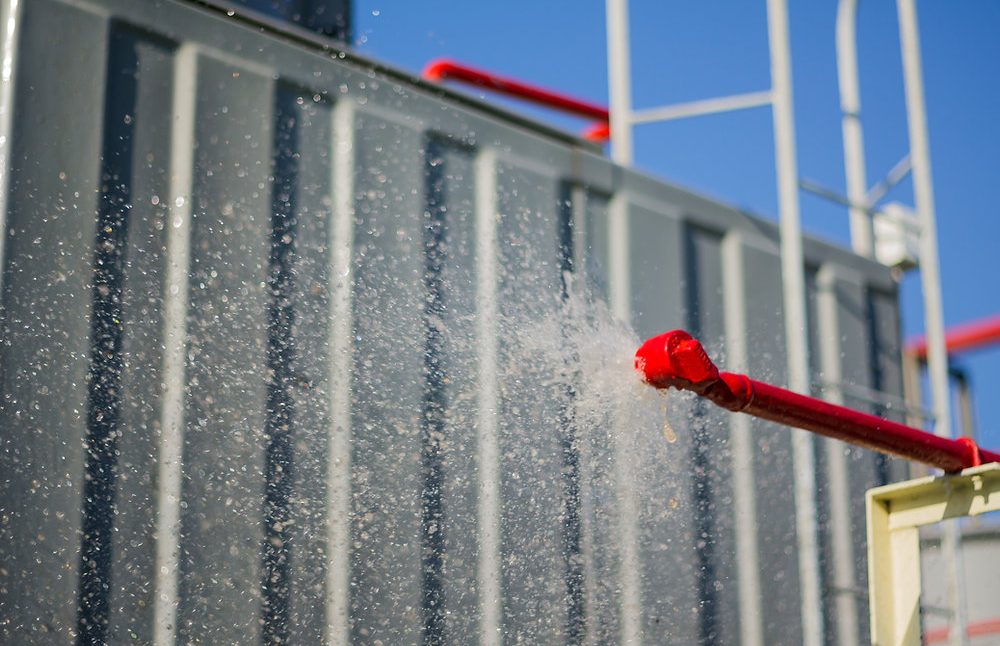Water spray systems are an essential part of industrial fire protection, designed to suppress fires and minimize damage to critical assets. These systems are particularly effective in controlling high-risk fire hazards in power plants, chemical facilities, and manufacturing industries. Among the most widely used water spray systems are medium velocity water spray systems and high velocity water spray systems. Each serves specific fire protection needs and is engineered to address particular fire risks.
Medium Velocity Water Spray System
What is a Medium Velocity Water Spray System?
A medium velocity water spray system (MVWS) is a fire suppression mechanism that discharges water at a moderate velocity, making it ideal for controlling Class B fires, which involve flammable liquids. These systems are commonly used in industrial facilities where overheating machinery, transformers, and oil-filled equipment pose a fire risk.
Components of a Medium Velocity Water Spray System
A typical MVWS system consists of several key components:
- Spray Nozzles: These are strategically positioned to ensure effective water distribution over the risk area.
- Piping Network: Delivers pressurized water to the nozzles.
- Control Valves: Regulate the flow of water within the system.
- Detection System: Activates the system when fire conditions are detected.
- Water Supply: Ensures an uninterrupted water source for fire suppression.
How Does a Medium Velocity Water Spray System Work?
Upon detecting a fire, the MVWS system activates, releasing water at a moderate velocity to form a mist that cools surfaces, absorbs heat, and prevents fire spread. This system is particularly effective in areas where excessive force could cause splashing of flammable liquids, potentially spreading the fire rather than extinguishing it.
Applications of Medium Velocity Water Spray Systems
- Transformers & Substations: Helps protect electrical equipment from fire hazards.
- Chemical Processing Plants: Used in facilities handling flammable liquids.
- Fuel Storage Tanks: Minimizes fire risks by cooling and suppressing vapors.
- Heat Exchangers: Ensures protection in industrial operations where overheating can occur.
High Velocity Water Spray System
What is a High Velocity Water Spray System?
A high velocity water spray system (HVWS) is designed for tackling high-temperature fires, primarily Class B and Class C fires, involving oil-based fuels and electrical equipment. It delivers water at a much greater speed, producing a powerful impact to break down flames and cool surrounding areas rapidly.
Key Components of a High Velocity Water Spray System
- High Velocity Nozzles: Designed to break water into small droplets that effectively smother flames.
- Water Supply Pumps: Ensure adequate water pressure to sustain system performance.
- Valves and Piping: Direct the flow of water to targeted areas.
- Fire Detection System: Automates system activation in case of fire.
- Sprinkler Heads: Distribute water with high kinetic energy for efficient flame control.
How Does a High Velocity Water Spray System Work?
Unlike medium velocity systems, HVWS systems disperse water at a much higher force, breaking up oil and fuel fires by disrupting the combustion process. The system quickly reduces the temperature of burning materials, helping prevent re-ignition.
Applications of High Velocity Water Spray Systems
- Turbine Rooms: Essential for cooling and fire suppression in power plants.
- Boiler Rooms: Helps contain fires that may originate from high-temperature machinery.
- Fuel Handling Areas: Protects against intense fires in locations handling oils or chemicals.
- Diesel Generators: Safeguards critical power backup systems from fire hazards.
Differences Between Medium Velocity and High Velocity Water Spray Systems
| Feature | Medium Velocity Water Spray System | High Velocity Water Spray System |
|---|---|---|
| Water Speed | Moderate | High |
| Fire Types | Class B (Flammable Liquids) | Class B & C (Oil & Electrical) |
| Cooling Effect | Slower, covers a wider area | Faster, focused cooling |
| Best Used For | Oil tanks, transformers | Boilers, turbines, generators |
Choosing the Right Water Spray System
Selecting between MVWS and HVWS depends on the specific fire risk in a facility. While MVWS is effective for protecting flammable liquid storage and electrical equipment, HVWS is ideal for tackling intense fires in power plants and industrial machinery.
Key considerations when selecting a system include:
- Type of fire hazard present
- Environmental conditions
- Required cooling effect
- Regulatory compliance and fire safety standards
Corporate Compliance and Risk Assessment
Organizations must conduct comprehensive fire risk assessments to determine the most effective fire suppression strategy. Ensuring compliance with NFPA, OSHA, and local fire safety regulations is crucial to maintaining workplace safety. A well-maintained water spray system can prevent costly damages, reduce downtime, and safeguard personnel.
Fire Safety Best Practices for Compliance
- Regular Maintenance: Ensure spray nozzles and piping remain clear of obstructions.
- Routine Inspections: Conduct periodic fire risk assessments to identify vulnerabilities.
- Employee Training: Educate staff on fire safety procedures and emergency response.
- System Testing: Perform scheduled tests to confirm the effectiveness of the water spray system.
Conclusion
Both medium velocity water spray systems and high velocity water spray systems play critical roles in industrial fire protection. Selecting the appropriate system requires careful evaluation of fire risks, environmental conditions, and regulatory requirements. Proper installation, maintenance, and compliance measures ensure optimal performance and enhanced safety for industrial facilities.


